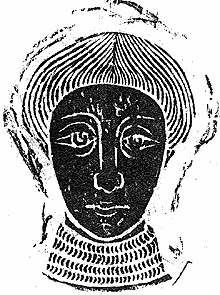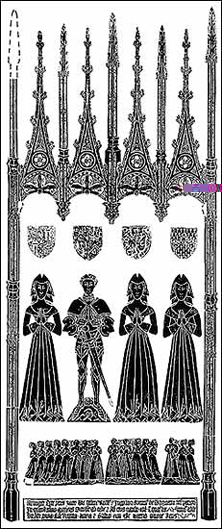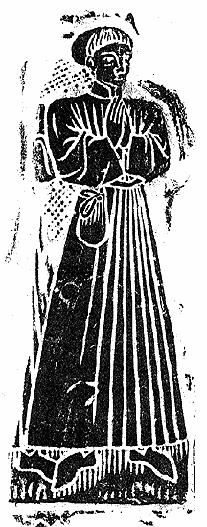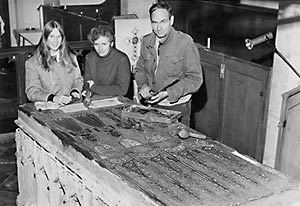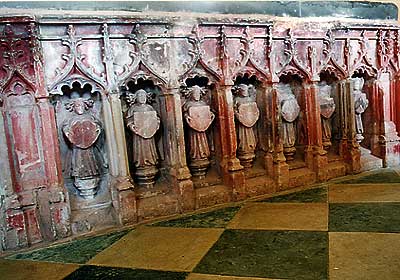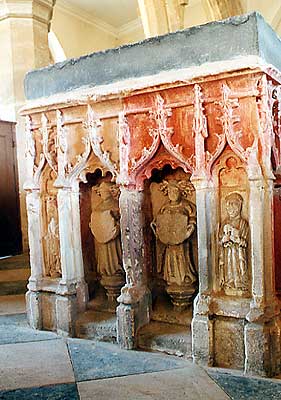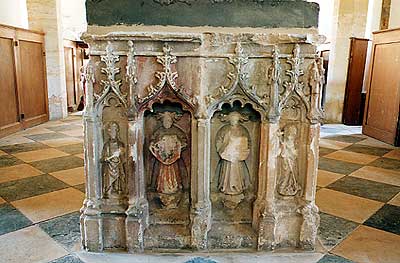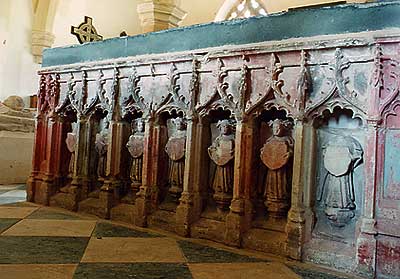The tomb was rebuilt inside the nave of St. Micheal's, after it was rescued from the Grotto in 1946-7.
MS1 Robert Ingleton, wives and children
Position in Church: Altar-tomb, centre of nave, originally in the centre of the Chancel.
Date made: 1472
Date inspected: 2 May 2002
Brasses: Brass figures of man in armour, head bare, standing on grassy mound, flanked by three wives, dressed identically in low-cut fur- trimmed kirtles and 'horned' head-dresses. Above the heads of the figures are four shields, largely made of lead, and below the figures are three groups of children, two boys with four girls, two boys with three girls, and one boy with two girls; the boys all in long gowns, the older ones with purses hanging from their waists, the girls all in kirtles and 'butterfly' headdresses; below the children again is an inscription in raised Gothic minuscule. The entire composition is framed by a canopy with four gables, in the centre of which are quatrefoils inscribed ih(esu)c M(er)cy Lady helpe, and under each gable is a groined vault with a boss representing a grinning face. The moulded edges of the slab with the indents for a lost marginal inscription (already mutilated in Willis' time), probably on the chamfer, have been cut away. The only parts missing are the top dexter pinnacle of the canopy, and a corner of the first group of children.
TOP
Style: London, D.
Inscriptions:
Armiger Ecce pius Jacet Hic tellure Rob(er)t(us)
Ingylton · Domin(us) de Thorneton jur(e) patron(us) /
In qui(n)to decimo · Moriens Octobr(is) ab orbe
sSit sibi p(ro)picia · celi Regina · Maria
Saluet eum (Christus)a · Matris amore Deus. a xpc
[Hic jacet Robertus Ingilton Armiger, quondam Dominus de Thornton, ac ejusdem Ecclesiae patronus, qui quondam erat juris peritus, et totius virtutis amicus, hic eciam tres requiescunt Uxores, Margareta, Clemens, et Isabella, et obiit Robertus isto xv ° Die mensis Octobris A.D. mill(es)imo cccc lxxii, quorum animabus p(ro)picietur Deus. Amen.]
|
See, here lies a pious squire under the earth, Robert Ingleton, Lord of Thornton and rightly its patron. He died and passed to heaven from this world on the fifteenth day of October, 1472. May Mary, Queen of heaven, be kindly to him, may Christ who is God save him for the love of his Mother. Here lies Robert Ingleton Esquire, once Lord of Thornton, who was once an expert in the Law, and a friend to all virtue. Here too lie three wives, Margaret, Clemency and Isabel; and Robert died on the 15th of October 1472; may God have mercy on their souls.
|
Script: Gothic textura quadrata.
Brass, Heraldry: I: Sable, two lions passant argent crowned or, DYMOKE, quartering Argent, a sword in pale point downwards sable, hilted gules, DYMOKE as Champion of England, for Margaret Dymoke, first wife.
II: Quarterly, i and iv, Argent, a chevron between three tuns sable, from the bunghole of each a flame issuing proper, on the chevron a molet for difference, INGLETON; ii, Argent, semy of crescents, a lion rampant azure, WANDESFORD, iii, Argent, three gryphons' heads erased and three crosslets fitchy azure, (?) an early form of INGLETON, for Robert Ingleton himself.
III: Argent, semy of crescents gules, a lion rampant azure, BEAUMONT (also used by Lister), for Clemens Beaumont, second wife.
IV: Ermine, on a chevron gules three leopards' heads jessant de lys or, CANTILUPE, for Isabel Cantelupe, third wife. [nos III and IV seem formerly to have been laid in reverse order]
Stone work: Brass set in grey plain Purbeck marble; set on tomb chest of freestone, with canopied niches containing figures, mostly painted red. At the ends of the two short sides are shallow niches, containing figures of saints. On the south side of the east end, a male saint in tunic and mantle, holding something across his body; suggestions have been St John the Baptist and St Bartholomew, though if the saints are intended to represent the patrons of the principal figures, it should be St Robert, hermit. At the north side a figure of St Margaret, crowned, and holding a long cross-staff with which she pierces the mouth of a small dragon. On the west end, on the north side, a virgin saint, crowned, with long hair, holding a sword in her right hand, the left hand raised holding something, possibly intended for a St Isabel. It is usually described as St Catherine, but there is no evidence of a wheel. On the south side, a male saint, in tunic and mantle, holding a pair of keys and a clasped book; this looks like St Peter, but might be intended for St Clement, also a Pope and writer, though usually distinguished with an anchor. At the ends of the long sides are very shallow niches, which probably never contained any imagery, unless painted. In between are deeper niches, two at each end and seven on each side, each containing angels with spread wings and long curly hair, each holding a shield. The shields were originally all painted, as recorded by Browne Willis; he gives names above each shield, which may have been painted on the chest, though it is difficult to see where. Many of these names are quite wrong. Some of these arms were still recognizable in 1948, and a few still in 2002, each time in different positions. They are described here in the original order, with Willis' labels, numbering in each case from left to right.
Tomb, Heraldry: East end: 1, INGLETON (tuns), labelled Sir R..., for Robert Ingleton.
2 blank (presumably once DYMOKE), M.I. for Margaret Ingleton.
South side: 1, INGLETON (tuns) quartering INGLETON (gryphons' heads), over all a label gules, John Ingleton, for the eldest son.
2, DYMOKE, Robt. Dymoke, for Margaret's father.
3, Argent, three wolves passant sable, LOVET, quartering Ermine, a bordure sable, TURVILLE, Thos. Lovet., for the brother-in-law of George, son of Robert Ingleton.
4, Vair, a fess gules, (?) MARMION, Thos. Dinton (in position south 2 in 1948, now south 3 ?); Dinton must be a misreading: Marmion was a connection of Dymoke.
5, Gules, three lions passant argent, over all a bend gules, GIFFARD, Kateryn Billing, for Katherine Giffard, wife of Sir Thomas Billing and grandmother of Robert Ingleton's daughter-in-law, though the bend is inexplicable.
6, Argent, a cross voided between four crosslets fitchee gules, BILLING, Thos Billing, for the father and grandfather of Robert Ingleton's daughter-in-law Sibyl Billing; (in position north 1 in 1948, now north 5).
7, Semee of crescents, a lion rampant, BEAUMONT, Margaret Ing., intended for Clemency, the second wife of Robert Ingleton.
West end: 1, INGLETON (tuns) quartering INGLETON (gryphons' heads) Robt. Ingleton.
2, blank (presumably once CANTELUPE), Isabel Ingleton
North side: 1, blank, Bernard Brocas, for Sibyl Billing's stepfather.
2, within a bordure, a chevron, quartering within a bordure two bars engrailed, (?) EMPSON, Th FitzWm. possibly for Anne Empson, wife of Robert, son of George and grandson of Robert Ingleton, but Sir Richard Empsdon only became guardian of the younger Robert on his father's death in 1494/5.
3, Quarterly, i, Argent, a cross [engrailed] gules, DRAYTON, ii and iii, gules a bend argent, (?) PRAYERS, iv, Argent, a chief indented azure, CRANFORD, Ann Lovet, for Ann, daughter of Thomas Lovett (brother-in-law of George Ingleton) and wife of Drayton.
4, Argent, a bend between six fleurs-de-lys gules, FITZELLIS, Robard Tillet, intended for Robert Fitzellis of Waterperry, d. 1470, father of Margery, wife of Thomas Billing and mother-in-law of George Ingleton.
5, Chequey argent and gules, a canton ermine, REYNES, John Reynes for the husband of Agnes, daughter of Charles and granddaughter of Robert Ingleton. (in position north 2 in 1948, now south 6).
6, Chequey or and azure, a fess gules fretty argent, CHEYNE, John Cheyne, for the husband of Margaret, daughter of Robert Ingleton, (in position south 1 in 1948, now north 6)
7, CANTELUPE, Clemens Ingleton actually for Isabel third wife of Robert Ingleton, (in position south 3 in 1948, now north 7).
Dimensions: Slab 2.31 x 0.92 m; brass figures 62 x 19, 62 x 22, 62 x 20 and 62 x 18 cm; groups of children 20 x 33, 20 x 24, 20 x 17 cm; verses 9 x 73 cm, shields 14 x 12 cm; canopy 2.15 x 0.90 m.
Notes: Robert Ingleton was Chancellor of the Exchequer to Edward IV, acquired the manor and advowsen of Thornton in 1464. The inquisitio post mortem gives his date of death as 17 October 1473, despite the inscription on the brass. His eldest surviving son seems to have been George, who died in 1494 and married Sybil, daughter and heiress of Robert Fitzellis of Waterperry. The arms on the brass shields relate directly to Ingleton's three wives; those on the side panels were explained by Greening Lamborn as relating to the marriages of his children, especially George, who must have chosen the heraldry, though the marriage with Empson seems far too late for this monument. The chancel and tomb were dismantled by 1806, the brass set level in the floor of the new truncated chancel, and the sides of the tomb used to decorate a garden grotto. They were discovered there in 1945, and salvaged in 1946-7, when the tomb was re-assembled in the church.
References: Mill Stephenson I; L.S.W. Bucks., p. 210; Lipscomb, Bucks., III, 118-22; V.C.H. Bucks., IV, 243-9; E. Greening Lamborn, 'The Ingylton Tomb at Thornton, Bucks.' in M.B.S. Trans., VIII, 186-91; 'When Gay Tombs are Robbed', in Notes and Queries, Dec. 14 1946, 244-6; E. Clive Rouse, 'Restoration of the Ingylton Tomb at Thornton, Bucks.' M.B.S. Trans. VIII, 316-319; R.H. Russell, 'The Monuments at Thornton, Bucks.' extracted from Records of Bucks. VII, (1891) 52-60; Browne Willis, Hundred of Buckingham, 1755, p. 303.
It is clear Robert Ingleton was a lawyer. The phrase 'iuris peritus' on the inscription indicates that. He presumably operated a county practice - the equivalent of a solicitor's practice today. He may have received instruction at the Inns of Court in London, but he couldn't have become a barrister otherwise he would have been shown on the brass in legal attire not armour. He as escheator (an obtainer of tax money for the Crown) for Northants and Rutland 1460-1, Justice of the Peace for Northants from 1460 and for Buckinghamshire (which suggests that he moved to Thornton from Northants) from 1463 to his death in the 1470's (Calendar of Patent Rolls 1452 - 61, p. 673; Calendar of Patent Rolls 146 -77, p.608).
His official career seems only to have lasted two years. He was common serjant of London 1454 - 6 and comptroller of the pipe in the Exchequer 1454 - 6. Why he quit both offices in 1456 is not known. In 1461 he was appointed chancellor of the Exchequer in reversion, but it never fell in. The appointment nevertheless suggests that he was of a considerable standing.
In later years many times a justice of oyer and terminer (Calendar of Patent Rolls 1461-7, pp. 35, 183; Calendar of Patent Rolls 1467-77, pp. 246, 247). Strangely for someone of his background he was never an MP. Nonetheless, it's apparent that he did have connections with the Yorkist regime, for he served as chancellor of the exchequer under Edward IV. This wasn't as grand as it sounds; it was the sort of post to which lawyers were often appointed. But it does indicate that he was well connected. A further indication of his affiliations is his appointment as attorney to John Tiptoft, earl of Worcester (P.A. Johnson, Duke Richard of York (Oxford 1988), p. 213n). In a pardon granted to him in 1469 shortly before his death he is described as 'gentleman, alias late of London': an indication of his metropolitan employments (Calendar of Patent Rolls 1467-77, p. 267). He is also described as being of 'Whissheton, Northants - probably the modern Whiston - and Thornton, Bucks, late escheator (C67/46, m.4). According to the 'Victoria County History of Buckinghamshire', iv, p. 245, he acquired the manor of Thornton in about 1463.
A certain amount of mystery appears to surround the date of the death of Robert Ingleton; according to the inscription on his alter tomb he died on 15th October 1472, but the inquisition post mortem gave the date 17th October 1473 (Victoria County History, Buckinghamshire, 1927 Vol. 4). When the church was ransacked by Cotton and Sheppard, only the brass plate was preserved and it was set together with that of Jane Tyrrell, in the pavement each side of the altar.
(Robert Ingleton number 2 - son of Robert Ingleton MS1)
According to the published (probably wildly inaccurate) Visitations of Bucks:
1. Jane, daughter of Robert Ingleton by Sibill, d. and h. of – Fitzells in Com. Oxon Esq. Mar. Humphrey Tyrell of Thornton. (Harl. Soc. 1566 edn. P.43; 1634 edn. P. 118) BUT the copy of the 1634 Visitation in the Antiqs. Library has the words in italics crossed out, and someone has written in “Anne d. and h. rd. Empson”
2. Margaret, the daughter of Robert Ingleton of Thornton married John Cheyney of Drayton Beauchamp, “she was breeding 23 Oct 33 H. 8 (1543). (Harl.Soc. 1566 edn. P. 9; 1634 edn. P. 153)
VCH Oxon Vol V, p.298, has rather more on the family Fitzellis;
Robert Fitzellis married Margaret Fawkener; their pictures remain in glass at Waterperry. She died a widow in 1469, leaving everything to her granddaughter Sibyl. Sibyl married George Ingleton (son of LSW I) who died 1494, leaving as heir Robert Ingleton (II) who married Anne, daughter, of Sir Richard Empson. On the death of Robert Ingleton II in 1503 his heiress Jane (brass LSW II) was only nine months old. She was the one who married Humphrey Tyrell. BUT that leaves Margaret, daughter of Robert Ingleton unaccounted for. We suppose she could have been a posthumous child of Robert Ingleton II, born say 1504, thus possibly still “breeding” in 1543. We can assume that Jane’s father as Robert grandson of Robert, irrespective of whether she was born 1501 or 1503.
The information above was very kindly provided by Father Jerome Bertram F.S.A
| |

